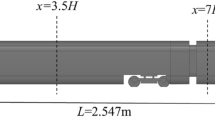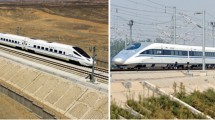Abstract
One of the most critical issues in railway industries is the influence of transverse winds, and when trains are at heights such as embankments, this problem becomes much more critical and concerning. In this research, the authors would argue the aerodynamic visions of a generic high-speed train that runs embankments of varying heights. The train's aerodynamic coefficients, pressure contours, and velocity streamlines were obtained using a numerical code based on large eddy simulation modeling. The high embankment is thought to have a direct impact on the changes in these aerodynamic coefficients. For example, raising the embankment height to 10 m results in a 300 percent increase and a 50 percent decrease in the side and lift force coefficients, respectively, compared to the flat ground scenario.












Similar content being viewed by others
Data Availability
The submitted article includes all data, models, and code created or used during the analysis.
References
Baker C (2010) The flow around high speed trains. J Wind Eng Ind Aerodyn 98:277–298
Baker C, Cheli F, Orellano A, Paradot N, Proppe C, Rocchi D (2009) Cross-wind effects on road and rail vehicles. Veh Syst Dyn 47:983–1022
Bell JR, Burton D, Thompson MC, Herbst AH, Sheridan J (2016) Flow topology and unsteady features of the wake of a generic high-speed train. J Fluids Struct 61:168–183
Bocciolone M, Cheli F, Corradi R, Muggiasca S, Tomasini G (2008) Crosswind action on rail vehicles: wind tunnel experimental analyses. J Wind Eng Ind Aerodyn 96:584–610
Cermak JE, Isyumov N (1999) Wind tunnel studies of buildings and structures. Rest U. S. Am Soc Civ Eng 1:9–15
Cheli F, Corradi R, Rocchi D, Tomasini G, Maestrini E (2010) Wind tunnel tests on train scaled models to investigate the effect of infrastructure scenario. J Wind Eng Ind Aerodyn 98:353–362
Cheli F, Giappino S, Rosa L, Tomasini G, Villani M (2013) Experimental study on the aerodynamic forces on railway vehicles in presence of turbulence. J Wind Eng Ind Aerodyn 123:311–316
Deng E, Yang W, He X, Zhu Zh, Wang H, Wang Y, Wang A, Zhou L (2021) Aerodynamic response of high-speed trains under crosswind in a bridge-tunnel section with or without a wind barrier. J Wind Eng Ind Aerodyn 210:104502
EN 14067–1, Railway applications—Aerodynamics—part 1: symbols and units. European standard, 2003
EN 14067–6, Railway applications-aerodynamics-Part 6: Requirements and test procedures for cross wind assessment. 2010
Guo Z, Liu T, Yu M, Chen Z, Li W, Huo X, Liu H (2019) Numerical study for the aerodynamic performance of double unit train under crosswind. J Wind Eng Ind Aerodyn 191:203–214
Hajipour A, Mirabdolah Lavasani A, Eftekhari Yazdi M (2021) Investigation of wall function effects on aerodynamic characteristics of turbulent flow around a simplified high-speed train. Int J Heat Technol 39:309–318
Horvat M, Bruno L, Khris S (2021) CWE study of wind flow around railways: effects of embankment and track system on sand sedimentation. J Wind Eng Ind Aerodyn 208:104476
Krajnović S, Davidson L (2005) Influence of floor motions in wind tunnels on the aerodynamics of road vehicles. J Wind Eng Ind Aerodyn 93:677–696
Krajnović S, Ringqvist P, Nakade K, Basara B (2012) Large eddy simulation of the flow around a simplified train moving through a crosswind flow. J Wind Eng Ind Aerodyn 110:86–99
Mohebbi M, Rezvani MA (2018) The impact of air fences geometry on air flow around an ICE3 high speed train on a double line railway track with exposure to crosswinds. J Appl Fluid Mech 11:743–754
Muld TW, Efraimsson G, Henningson DS (2012) Flow structures around a high-speed train extracted using proper orthogonal decomposition and dynamic mode decomposition. Comput Fluids 57:87–97
Niu J-Q, Zhou D, Liu T-H, Liang X-F (2017) Numerical simulation of aerodynamic performance of a couple multiple units high-speed train. Veh Syst Dyn 55:681–703
Niu J, Sui Y, Yu Q, Cao X, Yuan Y (2020) Aerodynamics of railway train/tunnel system: a review of recent research. Energy Built Environ 1:351–375
Noguchi Y, Suzuki M, Baker C, Nakade K (2019) Numerical and experimental study on the aerodynamic force coefficients of railway vehicles on an embankment in crosswind. J Wind Eng Ind Aerodyn 184:90–105
Raghunathan RS, Kim H-D, Setoguchi T (2002) Aerodynamics of high-speed railway train. Prog Aerosp Sci 38:469–514
Rashidi MM, Hajipour A, Li T, Yang Z, Li Q (2019) A review of recent studies on simulations for flow around high-speed trains. J Appl Comput Mech 5:311–333
Rezvani MA, Mohebbi M (2014) Numerical calculations of aerodynamic performance an ATM train at crosswind conditions. Wind Struct 18:529–548
Schober M, Weise M, Orellano A, Deeg P, Wetzel W (2010) Wind tunnel investigation of an ICE 3 endcar on three standard ground scenarios. J Wind Eng Ind Aerodyn 98:345–352
DIN standards committee railway/normenausschuss fahrweg und schienenfahzeuge (FSF). 2018
Tomasini G, Giappino S, Corradi R (2014) Experimental investigation of the effects of embankment scenario on railway vehicle aerodynamic coefficients. J Wind Eng Ind Aerodyn 131:59–71
Tsubokura M, Kobayashi T, Nakashima T, Nouzawa T, Nakamura T, Zhang H, Onishi K, Oshima N (2009) Computational visualization of unsteady flow around vehicles using high performance computing. Comput Fluids 38:981–990
Zhang J, Wang J, Tan X, Gao G, Xiong X (2019) Detached eddy simulation of flow characteristics around railway embankments and the layout of anemometers. J Wind Eng Ind Aerodyn 193:103968
Author information
Authors and Affiliations
Corresponding author
Rights and permissions
Springer Nature or its licensor (e.g. a society or other partner) holds exclusive rights to this article under a publishing agreement with the author(s) or other rightsholder(s); author self-archiving of the accepted manuscript version of this article is solely governed by the terms of such publishing agreement and applicable law.
About this article
Cite this article
Hajipour, A., Lavasani, A.M. & Yazdi, M.E. LES Study on the Embankment Height Effect on the Aerodynamic Characteristics of a Generic High-Speed Train. Iran J Sci Technol Trans Mech Eng 47, 829–839 (2023). https://doi.org/10.1007/s40997-022-00554-5
Received:
Accepted:
Published:
Issue Date:
DOI: https://doi.org/10.1007/s40997-022-00554-5




